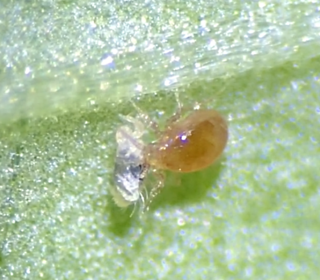
Mites are small arachnids. Mites span two large orders of arachnids, the Acariformes and the Parasitiformes, which were historically grouped together in the subclass Acari. However, most recent genetic analyses do not recover the two as each others closest relatives within Arachnida, rendering the group non-monophyletic. Most mites are tiny, less than 1 mm (0.04 in) in length, and have a simple, unsegmented body plan. The small size of most species makes them easily overlooked; some species live in water, many live in soil as decomposers, others live on plants, sometimes creating galls, while others again are predators or parasites. This last type includes the commercially destructive Varroa parasite of honey bees, as well as scabies mites of humans. Most species are harmless to humans, but a few are associated with allergies or may transmit diseases.

Arachnology is the scientific study of arachnids, which comprise spiders and related invertebrates such as scorpions, pseudoscorpions, and harvestmen. Those who study spiders and other arachnids are arachnologists. More narrowly, the study of spiders alone is known as araneology.

Acarology is the study of mites and ticks, the animals in the order Acarina. It is a subfield of arachnology, a subdiscipline of the field of zoology. A zoologist specializing in acarology is called an acarologist. Acarologists may also be parasitologists because many members of Acarina are parasitic. Many acarologists are studying around the world both professionally and as amateurs. The discipline is a developing science and long-awaited research has been provided for it in more recent history.

Varroa is a genus of parasitic mesostigmatan mites associated with honey bees, placed in its own family, Varroidae. The genus was named for Marcus Terentius Varro, a Roman scholar and beekeeper. The condition of a honeybee colony being infested with Varroa mites is called varroosis.

Tarsonemus is a genus of trombidiform mites within the family Tarsonemidae.

The Phytoseiidae are a family of mites which feed on thrips and other mite species. They are often used as a biological control agent for managing mite pests. Because of their usefulness as biological control agents, interest in Phytoseiidae has steadily increased over the past century. Public awareness of the biological control potential of invertebrates has been growing, though mainly in the US and Europe. In 1950, there were 34 known species. Today, there are 2,731 documented species organized in 90 genera and three subfamilies.

The International Journal of Acarology is a peer-reviewed scientific journal of agricultural, aquatic, general, medical, and veterinary acarology. Topics covered include mite and tick behavior, biochemistry, biology, biological pest control, ecology, evolution, morphology, physiology, systematics, and taxonomy. The journal was established in 1975 by Vikram Prasad. It was published by India Publishing House until 2008, when it was acquired by Taylor & Francis.

Harry Hoogstraal was an American entomologist and parasitologist. He was described as "the greatest authority on ticks and tickborne diseases who ever lived." The American Society of Tropical Medicine and Hygiene's Harry Hoogstraal Medal for Outstanding Achievement in Medical Entomology honors his contributions to science.

Rhizoglyphus is a genus of mites in the family Acaridae. It has a worldwide distribution and is often associated with the bulbs, corms or tubers of plants.
Schwiebea is a genus of mites in the family Acaridae. It is among the largest in the family with over 60 species.

Rhinonyssidae is a family of mites in the order Mesostigmata. There are about 16 genera and at least 460 described species in Rhinonyssidae.
Macrocheles muscaedomesticae is a species of mite in the family Macrochelidae. It has a cosmopolitan distribution.
The Systematic & Applied Acarology Society is an international society dedicated to promoting the development of the scientific discipline of acarology and facilitating collaboration among acarologists around the world. Founded in 1996, the society publishes three serial publications: the Acarology Bulletin, a newsletter of the society; Systematic & Applied Acarology, a refereed research journal; and Systematic and Applied Acarology Special Publications, a rapid publication for short papers and monographic works which was merged with the journal in 2012. It also occasionally issues books of special interest to members, and maintains an online acarological e-reprint library for acarologists around the world.

Aceria tosichella, commonly known as the wheat curl mite (WCM), is a global cereal pest and a vector for spreading and transmission of viruses like wheat streak mosaic virus (WSMV) and wheat mosaic virus (WMoV)
Erythraeus moeritzensis is a species of mite belonging to the family Erythraeidae. It belongs to the group of species that has a basifemoral, setal formula 3-3-3.
Erythraeus berninensis is a species of mite belonging to the family Erythraeidae. It belongs to the group of species that has a basifemoral, setal formula 3-3-3.
Phenopelopidae is a family of oribatid mites in the order Sarcoptiformes. As of 2018, there were 4 genera and 106 species known in this family.
Magdalena Kathrina Petronella Smith Meyer was a South African acarologist who was regarded as a world authority on plant-feeding mites of agricultural importance and was known as the "mother of red-spider mites of the world". She described more than 700 new species and 25 new genera, mostly of mites of agricultural importance. Meyer was involved in the promotion of biological control of mites using predatory mites, spiders and insects.
Ixodes anatis, also called the kiwi tick, is a species of tick in the arthropod family Ixodidae. It is endemic to New Zealand and mainly parasitizes kiwi.










